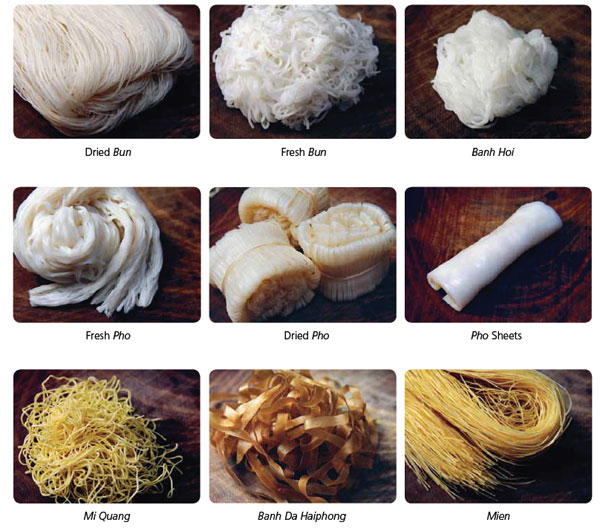
NOODLES
No Vietnamese meal would be complete without rice, but steamed rice can be difficult to prepare on the streets. Luckily rice can be served in many ways. Ground into flour, Vietnam’s most versatile staple is the basis for rice paper wrappers, dumpling dough and noodles.
In many ways, noodles are the ideal street food: they can be eaten fresh, cooked in broths, steamed or fried, while being easily transportable. The making of fresh noodles is still very much a cottage industry in Vietnam and visitors can find entire villages throughout the country that specialise in the craft of noodle making.
Bun (Rice Vermicelli)
Dough made from glutinous rice and water is pressed through a perforated container into boiling water to form thin, round noodles. After a few seconds in the boiling water, the noodles are removed and chilled. With bun, fresh is best. These chewy noodles have a shelf life of only 4 hours before losing their texture.
Bun is a culinary ‘all rounder’ – often served as a cold side dish with a dipping sauce like in the famous bun cha, but it can also be added to broths or fresh spring rolls.
Banh Hoi
Banh hoi are made from a similar dough to bun. They are very fine noodles and the delicate strands are interwoven into small squares. Banh hoi are served cold, often topped with roasted or grilled meats and accompanied by a dipping sauce.
Pho
Pho noodles are made from steamed noodle sheets, and the quality of the sheets is judged by their unblemished silky surface. The sheets can be used as a wrap for pho cuon (beef rice paper rolls), for example, or they can be cut into noodles: fettuccine-width for stir-fries and slightly narrower for the famous noodle soup of the same name.
Mi Quang
Mi are Chinese-style egg noodles and mi quang originated in the centre of Vietnam around the city of Danang and in Quang Nam Province, where noodle-makers often add turmeric to the dough as extra seasoning. The soft noodle has a similar texture to Japanese udon noodles and is used together with wontons, another ingredient Vietnam inherited from China.
Banh Da Haiphong
A variety from the northern port city of Haiphong, this reddish-brown noodle is firmer than bun or pho, which makes it ideal for lau (hotpot), where it is cooked at the very end of the meal in the rich broth.
Mien (Cellophane Noodles)
Not made from rice but from starch, these translucent, skinny noodles are the odd one out. The most popular variety, mien, are produced from mung beans, others from cassava or canna. Also known as glass noodles, they are sold in dried bundles and need to be soaked in boiling water before they can be used to add texture to fried spring rolls and salads.
